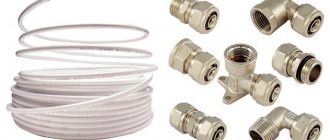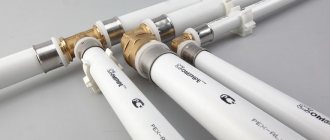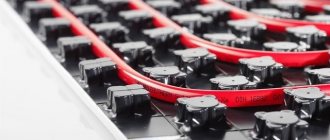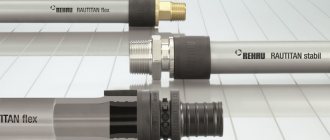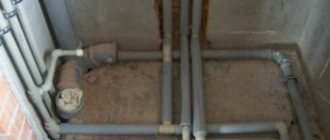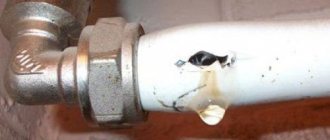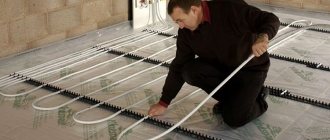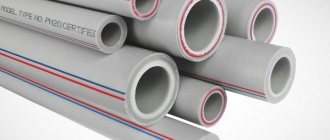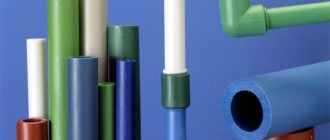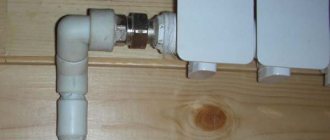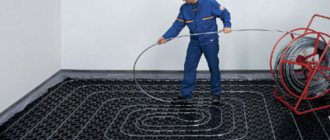Pipes made of polypropylene and metal-plastic are used in networks of low-rise and high-rise construction. In this article I would like to provide a series of comparisons of several types of pipes. In particular, these are 2 types of pipes - a metal-plastic pipe and a pipe consisting of polypropylene.
Which pipes are best suited for installing engineering systems in a house? There is no clear answer. When choosing, the homeowner must be guided by many parameters: the purpose of the system, the complexity of the design, the type of media, pressure indicator, temperature conditions, etc. The market offers several types of plastic pipes, but most often developers are concerned with the question of what is better: metal-plastic or polypropylene. In this material we will conduct a comparative criterion of these two types of pipes
Pipe features
The metal-plastic pipe consists of three layers. The outer one is made of protective polyethylene, the inner one is made of cross-linked polyethylene. And between them there is an aluminum layer. The layers are glued together with a special compound that secures them securely.
The inner layer easily withstands temperature changes and exposure to chemicals. It is antistatic, and the smooth surface does not interfere with the movement of liquid. Cross-linked polyethylene has molecular memory. This means that over time the material restores its original shape. This is a very important feature, since the pipe does not deform due to loads. There is no plastic slipping or clogging on corners.
The thickness of the aluminum foil layer is usually from 0.2 mm to 1 mm. The optimal value is 0.5 mm. This design minimizes expansion of the plastic due to heating.
Helpful information! Polyethylene and aluminum have different rates of thermal expansion. In low-quality pipes, temperature changes can cause layers to separate. Therefore, it is recommended to buy products from reputable manufacturers.
Advantages of polypropylene materials
- They are environmentally friendly.
- Conducts little heat.
- They do not conduct electricity.
- Resistant to corrosive and chemical processes.
- They are light in weight.
- Ease of installation.
- They serve for a very long time (up to 50 years).
- They don't have a high price.
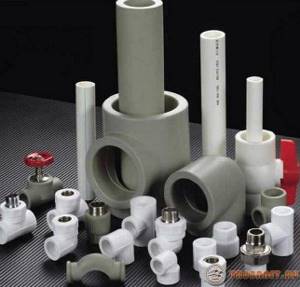
When choosing, first of all, you need to know how the piping system will be used. If it is intended to supply water, the system must withstand significant pressure.
If this is heating, then you need to take into account the higher temperature. If this is a sewer system, then a certain diameter is needed for normal functioning.
After this, you need to calculate the diameter, the required wall thickness and determine whether reinforcement is needed or not:
- For cold water supply, non-reinforced materials are better suited, but the walls must have a certain thickness.
- For hot water supply you will need reinforced pipes. Experts recommend using fiberglass reinforcement.
- For a sewer pipeline, the most important thing is the diameter.
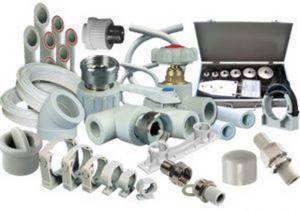
In the modern market, in addition to domestic manufacturers, you can find goods from Italy, Germany, the Czech Republic, Turkey and China.
The most popular among consumers are Turkish and Czech pipe products. Although German manufacturers have the highest quality, their products are too expensive. But the Chinese options do not cost much, but they are not of high quality.
Video
This is interesting: Minerite and mineralite slabs - important information
Differences between metal-plastic pipes
Advantages of metal-plastic pipes:
- The maximum temperature of the transported liquid is 110 oC;
- Maximum pressure - 25 atmospheres at a liquid temperature of up to 25 oC, 10 atmospheres at a liquid temperature of 95 oC;
- If you follow all recommendations for installation and operation, a metal-plastic pipeline for cold water will last from 50 years, for hot water - up to 50 years;
- The inner coating of the pipe is very smooth, nothing interferes with the transportation of liquid, and no blockages occur;
- High thermal conductivity, pipes are excellent for heating systems;
- The material is flexible; the product can be given the desired shape without the use of special tools;
- The length of the bay is from 50 to 200 m, fewer joints will be required;
- Easy to install, no welding required.
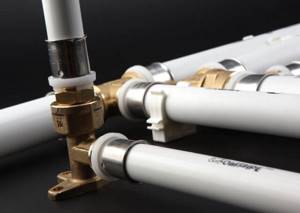
But they also have several disadvantages:
- Metal-plastic pipes, as well as materials for their fastening, are more expensive than plastic ones;
- Pipe diameter from 16 to 63 mm;
- It is not recommended to place metal-plastic pipes in walls, since the joints weaken over time;
- Icy water can lead to rupture of a metal-plastic heating pipe;
- Pipes are not resistant to thermal radiation, ultraviolet radiation, and mechanical damage;
- Metal-plastic pipes are not suitable for laying water fire extinguishing systems.
The best heating solution
The use of polypropylene pipes in organizing home heating is the most budget option. PPRs are very often used in the implementation of heating projects due to the cost-effectiveness of the option. Other advantages of the approach include:
- low weight of the pipeline, facilitating transportation and work; lightness is especially attractive in cases of subsidence of a building or its foundation on moving soil;
- Possibility of closed installation in the wall;
- long service life of the system;
- independence from heating seasonality: for example, if a country house is turned off during the winter, the pipes will not freeze;
- ease of hygienic processing.
Flaws:
- some complexity of installation due to numerous soldering and joining works; work on installing heating in a two-story building will take considerable time;
- claim to heat resistance, which is 700C;
- sagging of pipes on long sections of the network due to their low rigidity;
- high linear expansion rate, requiring additional installation of expansion joints during closed-type installation.
If polypropylene is a favorite among thrifty citizens, then metal-plastic is a material for those who value minimal labor intensity and the number of “troubles.” Briefly about other advantages:
- high temperature resistance;
- oxygen impermeability;
- low coefficient of linear expansion, which allows you to easily install a closed-type heating system;
- silent operation due to the smoothness of the inner surface of the walls.
Among the disadvantages, special attention should be paid to the fact that the episodic nature of turning on the heating system can very quickly disable it, since the metal-plastic pipes freeze and become deformed (when it comes to winter).
Are polypropylene pipes better?
The area of application of polypropylene pipes coincides with metal-plastic pipes; they are competitors. The characteristics of the products are identical in most respects, since most of them are plastic. But their performance characteristics still differ. And many people do not understand what is better: metal-plastic or polypropylene pipes.
The second type of product is used in plumbing, heating, ventilation systems, and so on. There are different types of polypropylene pipes. For the installation of heating systems, polypropylene is used, reinforced with aluminum foil with holes or fiberglass. Such reinforcement reduces thermal deformation by an order of magnitude.

Distinctive features of polypropylene pipes:
- Resistance to mechanical stress, increased strength;
- The reinforcing layer is sealed into the walls of the product, so delamination is impossible, temperature changes do not affect the integrity;
- Icy water cannot rupture or in any way deform the water supply system, and the same applies to hot water. After exposure, the pipe takes its original shape;
- Possibility of transporting substances with chemical additives without harm to pipes.
Recently, antioxidants have been added to polypropylene pipes, making them resistant to oxidation by chlorine. Therefore they are suitable for transporting drinking water.
Technical characteristics of polypropylene pipes:
- Maximum temperature - 95 oC;
- Maximum pressure 25 atmospheres at temperatures up to 25 oC, 7 atmospheres at temperatures 95 oC;
- The service life of the pipe when transporting hot water is 25 years, cold water - over 50 years;
- Installation of a polypropylene pipeline is much cheaper due to the low cost of components;
- Reinforced water supply can be installed under tiles.
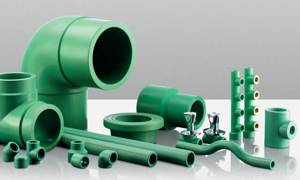
Flaws:
- If you plan to transport high-temperature liquid at high pressure, then the service life of the pipes will be no more than 3 years;
- No UV resistance;
- Not suitable for placement in facilities with a high fire hazard;
- More complex installation, since the pipes do not bend.
- Hot mounting requires experience and special tools.
- The pipes are not suitable for use in regions with significant negative temperatures.
An important difference between metal-plastic pipes and polypropylene pipes, which must be taken into account when choosing, is the installation method. It varies greatly for each type of product.
Types of connection of metal-plastic pipes
Detachable fittings. They are divided into collet and threaded. Detachable fittings allow you to repeatedly dismantle the system and disconnect it from another fitting or device, which affects the cost of such fasteners.
Conditionally detachable fittings (compression). This type of fitting is very difficult to undo. If there is a need to dismantle the structure, then when reinstalling it, the ferrule ring will need to be replaced, therefore, it makes sense to uncouple only if absolutely necessary.
Press-fitting or one-piece. This type of connection cannot be disassembled; the pipes are pressed into the fitting once and for all without the possibility of uncoupling in the future.
The first two types of connection of metal-plastic pipes involve the presence of threads, so it is necessary to have access to the connection point for preventive actions during operation of the system. This means that it is impossible to hide the structure behind a wall. The press-fit connection is permanent, so it can be sealed without worry. As a rule, metal-plastic products last more than 50 years if the temperature of the transported substance does not exceed the permitted values and the operating pressure is less than 10 atmospheres.
The only noticeable disadvantage of metal-plastic pipes is their instability to ultraviolet rays, so they must be protected from direct sunlight, exposure to open fire and mechanical damage. Some manufacturers provide a hidden protective gasket in their products.
Installation of metal-plastic pipeline
In a metal-plastic pipeline, the weakest link is the joints. It is almost impossible to achieve complete tightness on them. Therefore, it is necessary to select high-quality materials and perform installation as accurately as possible. There can be no talk about the longevity of joints in an apartment building, since fluctuations in pressure and temperature can lead to the collapse of layers with leakage. But in a private house everything is different. These indicators are much more stable, so the service life of the products corresponds to the declared one.
Metal-plastic pipes are quite easy to install. You can easily do it yourself; all you need is a wrench. First, the pipeline is laid out. And then they move on to joining the pipes (about
Reviews from professionals
Konstantin, heating specialist. Most polypropylene pipes are suitable for cold water supply, and use in heating will lead to deformation and melting of the material. In a private house, in the absence of pronounced surges in pressure and temperature, wiring is made from reinforced polypropylene with markings indicating suitability for such tasks. But metal-plastic is better.
Andrey, builder. Polypropylene is easily deformed by hot water, and, on the contrary, it is more resistant to freezing than metal-plastic. Polypropylene also has a high coefficient of linear expansion. Metal plastic also wins in terms of flexibility.
In terms of reliability, flexibility, and withstanding deviating coolant parameters, metal-plastic products show the best results. If it is impossible to allocate funds for such products, reinforced polypropylene is used if the heating characteristics are suitable for its operation.
Installation of polypropylene pipes
The main advantage of polypropylene products is monolithic joining. The layers of the pipe are soldered together at high temperature using a special soldering iron. Therefore, individual elements become a single whole. Leakage is impossible in polypropylene pipes; they are often mounted in walls. But they are not suitable for use in rooms with temperatures of 0 oC and below.
Connecting polypropylene pipes is a much more complex process. It is performed using soldering. In this case, preliminary preparation is necessary (the pipe cut is cleaned, dirt is removed from the surface). The pipes themselves are not deformed, so water pipe bends are made by soldering additional elements. Although the materials themselves are cheaper, installation in the case of polypropylene pipes will be more expensive when compared with metal-plastic products.
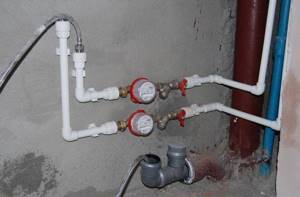
As in the previous case, installation must fully comply with the technology. Only a person with experience in this matter can perform the task correctly. An amateur cannot cope with high-quality installation of polypropylene water supply.
Polypropylene pipes with reinforcement are intended for heating and hot water supply systems, because a simple analogue is deformed when exposed to high temperatures. Fastening of products is carried out using the sliding method. The riser is secured with hinges during installation.
Pros and cons of polypropylene reinforcement
The list of advantages of PP pipes of any type includes the following facts:
- Low roughness of the inner surface of the reinforcement. A smooth pipe does not accumulate silt deposits.
- High heat resistance, due to which the surface of the pipe is not covered with condensation.
- Inertness of the structural material. Polypropylene does not rust, does not react to acids and alkalis, and does not change the quality of water.
- Record low density. The weight of PP fittings is nine times lower than the weight of steel pipes. Therefore, it is easy to install and transport.
In addition, we cannot fail to mention the record service life of such fittings. For hot water supply or heating, the period of operation of a PP pipe is 50 years, and for a water supply system (cold branch) - 100 years.
The disadvantages of PP fittings include a noticeable tendency to thermal expansion, which forces the use of a special installation technology. In addition, such pipes cannot be bent, so special fittings must be used to make bends. However, the technology of reinforcing pipes with fiberglass can reduce the effects of thermal expansion to acceptable levels.
Criterias of choice
You will be able to correctly understand whether metal-plastic or polypropylene pipes for water supply are more suitable if you take into account the following nuances:
- What is the purpose of using pipes ? If you plan to transport cold water, then polypropylene is preferable; there will be no leaks in it. Metal-plastic products with press fittings will be optimal for implementing a heated floor system. An experienced specialist will be able to suggest the best option for supplying hot water or installing a heating system (pro
Comparison of metal-plastic and polypropylene
To determine whether a metal-plastic pipe is better or a polypropylene pipe, you need to carefully consider both options from all sides. In some cases, metal-plastic will be the best choice, and in others, polypropylene. It all depends on the specific conditions of installation and operation of the future pipeline.
Criterion #1 - pipe performance
In terms of plasticity, polypropylene is somewhat stiffer than metal-plastic. The second pipes are easier to bend, which simplifies their transportation and installation. This rigidity is related both to the hardness of the plastic itself and to the thickness of the pipe walls made from it. With the same performance characteristics, polypropylene products are thicker than metal-plastic ones.
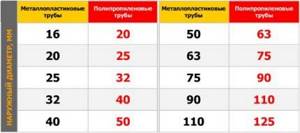
Unlike polypropylene, metal-plastic pipes are bent. It is they that are recommended to be used when installing a “warm floor” with its laying in a spiral without additional connections at the corners.
Disadvantages of metal-plastic
- flammability;
- intolerance to direct sunlight;
- low resistance to mechanical loads and damage;
- the need to ensure access to connections to monitor possible leaks;
- narrowed bore section of fittings;
- poor tolerance to temperature changes;
- higher risk of breakthrough at the joint than polypropylene.

Thus, there is no clear answer to the question of which pipes are better. The main thing to be guided by when choosing is the operating conditions of the water supply system.
Narrowing of the section on fittings
This is where the main drawback of pipes made from MP appears - they have a strong narrowing in metal fittings. If you took a ¾ pipe, then you will have ½ inch in the metal corner (see picture). A smaller cross-section than that of the inlet pipe leads to hydraulic shocks, which in turn affect the rate of failure of the joint. Of course, at normal (not exceeding permissible values) pressure, for example, in heating pipes, you can not be afraid of getting a water hammer, and the fittings will work fine for many years. But with pressure drops in the water supply, the destruction of connections will occur faster.
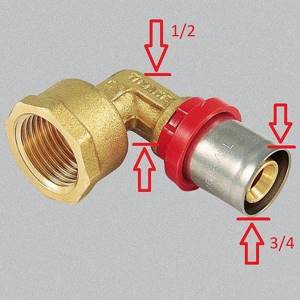
PP does not have this problem, and the cross-section of the fittings is equal to the cross-section of the pipes being connected. Therefore, when purchasing material, we simply take pipes and all connecting elements of the same section.
Number of connections
Here there is a clear advantage for metal-plastic, since the pipe itself does not come in pieces, but in a coil. Pipeline can be bent using a lever or spring bender to accommodate corners and curves. And although it is impossible to bend the pipe at an angle of 90°, in most cases this is not required. Due to this, the number of connections can be significantly reduced. In this case, the entire heating or plumbing system can be designed in such a way that the monolithic pipe is hidden in the wall, and the connections are accessible for maintenance.
Polypropylene pipes are sold in pieces of 2 m, so a large number of joints and fittings cannot be avoided. Taking this into account, PP pipes should not be installed under the wall, but rather routed outside so that the connections are always accessible. If any joint starts to leak, you will notice it in time and will not flood your neighbors.
Why is polypropylene good?
Various Internet resources have published many materials praising polypropylene (PP-R) and attributing mythical properties to it. To figure out which pipes are best to use for heating installation (including with your own hands), you need to identify the real pros and cons of PPR. If you study the advice of experts and reviews of homeowners on forums, the following picture emerges:
- The price of polypropylene pipes and fittings is the lowest among other plastic pipelines used for heating.
- PPR is harder and more durable than any polymer that is now used to install heating systems in private houses.
- High-quality heating made of polypropylene looks no worse, or even better, than steel or metal-plastic pipelines.
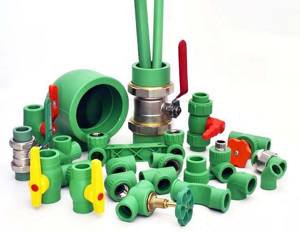
Note. We do not take into account the inherent advantages of all plastic pipes. For example, the absence of roughness on the inner surface, low hydraulic resistance, and not susceptible to corrosion.
The low price of polypropylene parts compared to metal plastic is the most attractive factor. The secret of the low cost lies in the design of the fittings, which are ordinary plastic castings that do not have a reinforcing layer. And the cost of PPR pipes with a reinforcing aluminum insert used for heating will not make you faint.
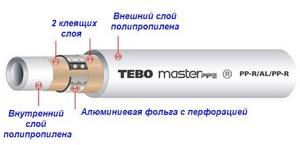
Perforated aluminum foil, basalt and fiberglass can act as a reinforcing layer of PPR pipes
The strength of propylene also plays an important role; it is quite difficult to break it. This favors the laying of highways in an open way in any place. The aesthetics of a beautifully assembled polypropylene system is also not the last factor, although this is not easy to achieve, as will be discussed below. This is where the positive aspects of the material end. But in order to understand what is better - metal-plastic or polypropylene, we need to consider the negative ones.
Comparison of materials
When choosing metal-plastic or polypropylene pipes for heating, the homeowner must understand the behavior of these materials during operation. You also need to take into account the requirements for the installation of different types of pipes.
Metal-plastic products can withstand hot coolant well without deforming or bursting. They can last up to 50 years in such conditions. For polypropylene pipes, such deadlines are only possible for models with a reinforcing layer and a mark indicating compatibility with boiling water. If you pour hot water into a PP-B or PP-N pipe at least once at a sufficiently high pressure, it will last for a maximum of a couple of years after such an incident. These products are initially intended only for laying water pipes at low temperatures.
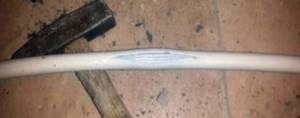
If the coolant freezes, the metal-plastic material bursts
In terms of frost resistance, the characteristics of pipes made from these materials are identical: under no circumstances should the coolant be allowed to freeze. Moreover, metal-plastic, which shows superiority in most operational parameters, in this case is destroyed immediately. Polypropylene products can withstand expansion caused by ice for a short time.
With a sharp temperature jump, metal-plastic products come apart due to different expansion rates of the constituent materials. This applies to freezing and the sudden supply of hotter water. In the first case, the weld of the metal part may completely burst. Polypropylene expands and the pipes sag. If they hit the wall, the pipeline may collapse. This is important to take into account during installation: the communications device must include sliding supports.
With a limited budget, the price category often becomes the main one when choosing polypropylene or metal-plastic pipes. The first material wins - the price of products made from it is 2-3 times lower. The fittings are also cheap, which cannot be said about those for metal-plastic: the pipes themselves are quite acceptable for the budget, but the mounting parts can be very expensive.
The advantages of polypropylene include its elasticity, due to which the communications remain sealed even after the frozen water in them begins to thaw. Reinforced options are resistant to mechanical stress and have thicker walls. The material is not subject to corrosion and is not destroyed by the low quality of the coolant, and has dielectric properties. It is very lightweight, which simplifies transportation and installation. On sale you can find fittings of various configurations for laying communications, including those that include pipes made of other materials.
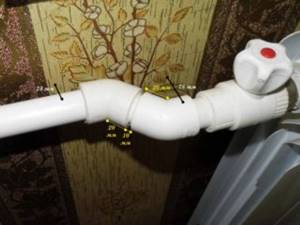
You cannot bend polypropylene - you need to use fittings
The main disadvantage of this plastic in terms of installation is the lack of flexibility. Even to create a slight rotation of the contour, you need to weld in outlet elements or adapters. If some section of the communication is damaged, its complete replacement is required: the welded joint cannot be repaired. When carrying out installation work, this must be taken into account: before and after a potentially problematic unit (for example, a fitting or tap), smooth fragments are left so that the unit can be cut out and a new one inserted. Also, if the joints are welded poorly, there is a risk that with a sharp increase in temperature, the plastic will melt and block the path of the coolant. If you have no experience in laying such communications, it is better to entrust the job to the experts. You should definitely not use polypropylene for centralized heating: the material does not tolerate the sudden changes in temperature and pressure inherent in this system.
Metal-plastic, on the contrary, is flexible and able to hold the shape that was given to it. However, there will be problems with small radii - trying to bend the pipe in this way can break it. It is better not to bend it manually, but to use spring parts or a pipe bender. The latter ensures smooth configuration. Other advantages include the smoothness of the inner walls, which creates the best circulation, and good tolerance of hot coolant.
The main disadvantage of metal-plastic is its unsatisfactory behavior when water freezes: the walls are easily torn.
